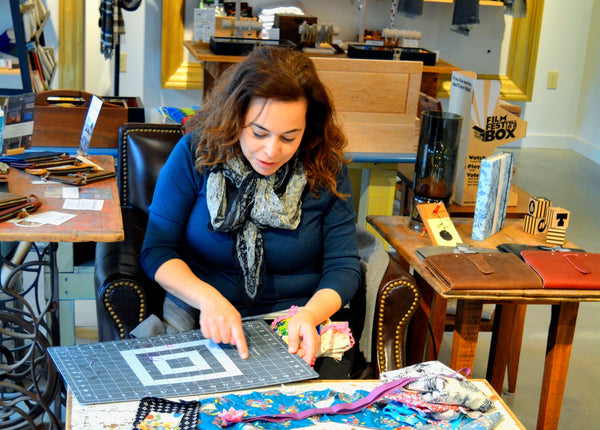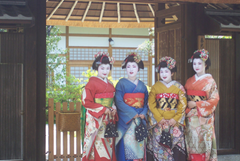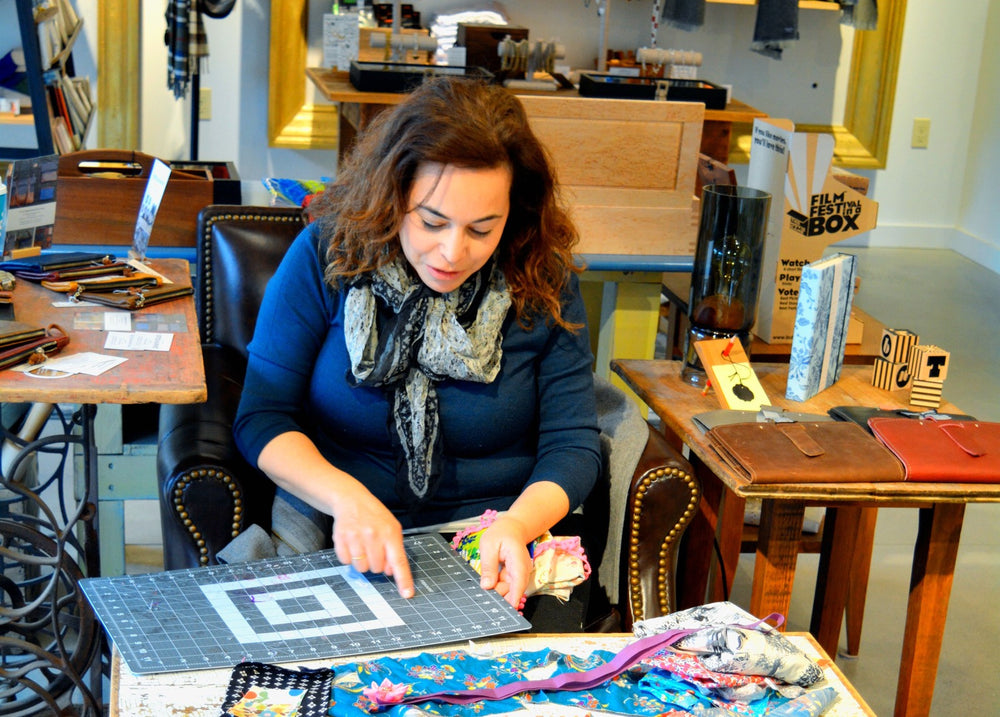For the rest of December and into January, our Featured Maker is Lisa Ramirez of A Flower for Rose! Lisa makes modern, beautiful hair accessories based on a Japanese folding art. Lisa has long been on of our most local makers and our most enthusiastic supporters and we're thrilled to finally have her in the store for our first in-person interview!

Quinstance: So let’s start with the Japanese arts that you do. What are they called?
Lisa Ramirez: I do tsumami kanzashi. Tsumami means the cloth folding art, transforming it into the petals of the flowers. Kanzashi is the Japanese hair adornments which include any kind of hair accessories. It’s the term for what geishas would wear.
Q: How did you come to learn these crafts?
LR: I lived in Japan, in Tokyo, for 2 years from 2005 to 2007. During the last part of time there my husband and I went to Kyoto. I have a picture of apprentice geishas—called maikos—they wear the kanzashi hair pieces. They are very elaborate.

When we got home, I looked it up online, and started learning it online from tutorials and videos.

Q: What can you tell me about the practice in Japan?
LR: The tradition in Japan is actually dying out. There are not many people who can do this professionally. It is an art form passed from master to apprentice, and the interest is drying up. Some people still do it as a craft, but not as much in the traditional ways.
Q: That seems to be a pattern with Japanese traditional arts. Nellie Rose Davis said much the same thing.
Q: What do you use to make your pieces?
LR: Well, the traditional material used for these is the same as they use for kimonos. I think it is a kind of Japanese silk. You do still see women wearing kimonos, even though modern fashions are more common. My husband still goes to Japan on business, and he brings back the scraps of material from the fabric shops there. They have baskets of scraps that can search through. You can also use linen and cotton.

Q: Is it easier to work with the kimono material, the Japanese silk?
LR: Honestly I like working with non-traditional materials more than the Japanese silk. Thick cotton and linen hold their shape much more than it, which is something I learned from practice. I do like to use the linens from Japanese designers.
Q: What goes into making each piece?
LR: I start out with squares of fabric, usually cut into 2 inch squares. I don’t like working so large though, that’s how I start out and they didn’t quite look the way I wanted them to. So I cut the squares down into 1 inch or half inch squares.

I fold the individual petals from these squares.

Then comes keeping the petals together. I used to use rice paste, which is made from boiling rice, which is the traditional way. They would take a small board, cover it with rice paste, stick the individual petals on the board to the petals don’t come undone while you work. But I found that ineffective, so I now use hot glue. There was a lot of playing around with the technique.
Lisa demonstrated to us the technique of folding individual petals.
LR: When I studied it originally, I was told to sew the petals together. I found that was a little messy with the thread showing, so I started with the rice paste.
Q: How do you select which fabrics you want to use?
LR: It depends on the color for me. Two pieces of material might be lying next to each other, and I’ll decide that they work together. The material might be anywhere around me though, I’m working on organizing better. Ultimately, it depends on the color combinations I want to do.
If I use a fabric with an animal in the pattern, I like to hide the animal in the petals.

Q: How long does it take you to make each piece?
LR: For a large flower, to fold all the petals and stick them together, takes about an hour. To make a more elaborate piece, like the headbands with a lot of little flowers, that takes about a day. But that’s usually because I’m distracted by my children or the dog.
Q: How did you decide to start selling pieces?
LR: I got back from Japan in 2007, but I didn’t begin selling my pieces until 2011 or 2012 when I started on Etsy.
It seemed like the easiest way to get started at the time, but it can be quite difficult to get noticed on there. There are millions of people on there. The marketing aspect is challenging for me, far more than making.

Q: It’s true for a lot of artists.
LR: I started doing Etsy wholesale. More people notice you that way, and stores shop on there.
Q: Why “A Flower for Rose”?
My daughter’s middle name is Rose. It was just a play on that. I liked the idea of it being a flower for someone, and I played around with that for a while, and I ended up with Rose.
She does some of the modeling for my Etsy site; she is really silly and making faces so it is tough, but I get some good shots.
Q: What is next for you?
I’m going to a craft show this weekend. I’m considering going to more trade shows, possibly having my own website as well.

Q: Lisa Ramirez, what is your quinstance?
LR: Hmm, that is a tough one. I could say my children or my dog. Do people count?
Erin Sandler, Quinstance Owner: Not usually.
[Lisa and Erin discuss what a quinstance means. When Erin mentions that can be a place:]
LR: Maybe then I would say Prince Edward Island. I go to Prince Edward Island every summer with my family; I was brought up in New Brunswick, and my family has a cottage there.
Every time we go to the cottage, it feels like going home for me.


